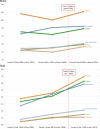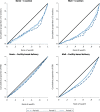Do free caesarean section policies increase inequalities in Benin and Mali?
- PMID: 29871645
- PMCID: PMC5989420
- DOI: 10.1186/s12939-018-0789-x
Do free caesarean section policies increase inequalities in Benin and Mali?
Abstract
Background: Benin and Mali introduced user fee exemption policies focused on caesarean sections (C-sections) in 2005 and 2009, respectively. These policies had a positive impact on access to C-sections and facility based deliveries among all women, but the impact on socioeconomic inequality is still highly uncertain. The objective of this study was to observe whether there was an increase or a decrease in urban/rural and socioeconomic inequalities in access to C-sections and facility based deliveries after the free C-section policy was introduced.
Methods: We used data from three consecutive Demographic and Health Surveys (DHS): 2001, 2006 and 2011-2012 in Benin and 2001, 2006 and 2012-13 in Mali. We evaluated trends in inequality in terms of two outcomes: C-sections and facility based deliveries. Adjusted odds ratios were used to estimate whether the distributions of C-sections and facility based deliveries favoured the least advantaged categories (rural, non-educated and poorest women) or the most advantaged categories (urban, educated and richest women). Concentration curves were used to observe the degree of wealth-related inequality in access to C-sections and facility based deliveries.
Results: We analysed 47,302 childbirths (23,266 in Benin and 24,036 in Mali). In Benin, we found no significant difference in access to C-sections between urban and rural women or between educated and non-educated women. However, the richest women had greater access to C-sections than the poorest women. There was no significant change in these inequalities in terms of access to C-sections and facility based deliveries after introduction of the free C-section policy. In Mali, we found a reduction in education-related inequalities in access to C-sections after implementation of the policy (p-value = 0.043). Inequalities between urban and rural areas had already decreased prior to implementation of the policy, but wealth-related inequalities were still present.
Conclusions: Urban/rural and socioeconomic inequalities in C-section access did not change substantially after the countries implemented free C-section policies. User fee exemption is not enough. We recommend switching to mechanisms that combine both a universal approach and targeted action for vulnerable populations to address this issue and ensure equal health care access for all individuals.
Keywords: Benin; Caesarean section; Health equity; Health policy; Low-income countries; Mali; Maternal health; User fees.
Conflict of interest statement
Ethics approval and consent to participate
Not applicable.
Competing interests
VR has served as a consultant on the issue of user fee abolition to non-governmental organizations in West Africa.
Publisher’s Note
Springer Nature remains neutral with regard to jurisdictional claims in published maps and institutional affiliations.
Figures



References
-
- Boatin AA, Schlotheuber A, Betran AP, Moller A-B, Barros AJD, Boerma T, et al. Within country inequalities in caesarean section rates: observational study of 72 low and middle income countries. BMJ. 2018;360 Available from: http://www.bmj.com/content/360/bmj.k55.abstract. - PMC - PubMed
Publication types
MeSH terms
Grants and funding
LinkOut - more resources
Full Text Sources
Other Literature Sources
Medical

